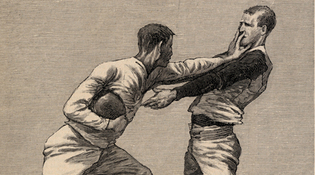 loading
loading
Arts & CultureObject lessonRemington on the gridiron W. Barksdale Maynard’s books include Woodrow Wilson: Princeton to the Presidency (Yale University Press, 2008) and Princeton: America’s Campus, to be published in May by Penn State University Press.  Manuscripts & ArchivesRemington thought football was "best at its worst." This image, "Brushing Off," was one of a series he published in Harper's Weekly in 1888. View full image
Before he became famous for paintings and sculptures of cowboys, Frederic Remington 1900BFA drew pictures of the Yale football team, on which he played as an art school student. With these tentative early drawings he taught himself to be an artist—one of America’s most beloved. Born 150 years ago this October in upstate New York, Remington entered the Yale School of the Fine Arts in 1878. He spent a boring first year drawing from plaster casts in the basement of Street Hall. His fellow art students were mostly women (the only female students at Yale). Seeking manly diversion, he sketched a bandaged football player for the Yale Courant—his first published illustration. And he soon joined the football team himself as forward, alongside quarterback and future football legend Walter Camp ’80. The team was noted for its roughness—bending necks, kneeing, punching, throttling—all of which the burly, blond Remington thoroughly enjoyed. He is said to have once dipped his football jersey in slaughterhouse blood before a game to make it look “more businesslike.” Remington would later embellish his experiences at Yale and after, telling interviewers he helped Walter Camp reinvent football and then spent four dashing years as a cowboy. The truth was more mundane. Quitting art school after three semesters once his father died, he moved to Kansas, partnering with fellow Yale dropout Robert Camp in running a miserable sheep ranch. Eventually he fled to New York for an artistic career. (He submitted work to Yale in 1900 to earn his BFA.) In the 1880s, he began to have success publishing western-themed drawings in eastern periodicals. A decision by Harper’s Weekly to print illustrations of the major football teams gave him a different kind of opportunity. (The cameras of the time were barely capable of capturing sports motion.) The wood engraving seen here, “Brushing Off,” was one of a group published in 1888 as A Practice Game at Yale by the Champion Football Eleven. The young man wasn’t yet producing his best work, says Yale art historian Alexander Nemerov ’92PhD, but his football pictures have a “crackling vitality.” The image reflects Remington’s experience of football as a violent and brutal sport. Others in the series depicted players with visible injuries, engaged in big hits, or crushed under scrums. “Football, in my opinion, is best at its worst,” Remington had once told Camp, in defense of a pastime some considered too violent. “I do not believe in all this namby-pamby talk, and hope the game will not be emasculated and robbed of its heroic qualities.” Long after Yale, football continued to inform his work. In his well-known paintings of the Spanish-American War, military charges oddly resemble football plays. “War was understood to be a game,” Nemerov says. “But Remington was disabused of that once he was shot at.”
The comment period has expired.
|
|